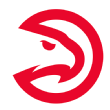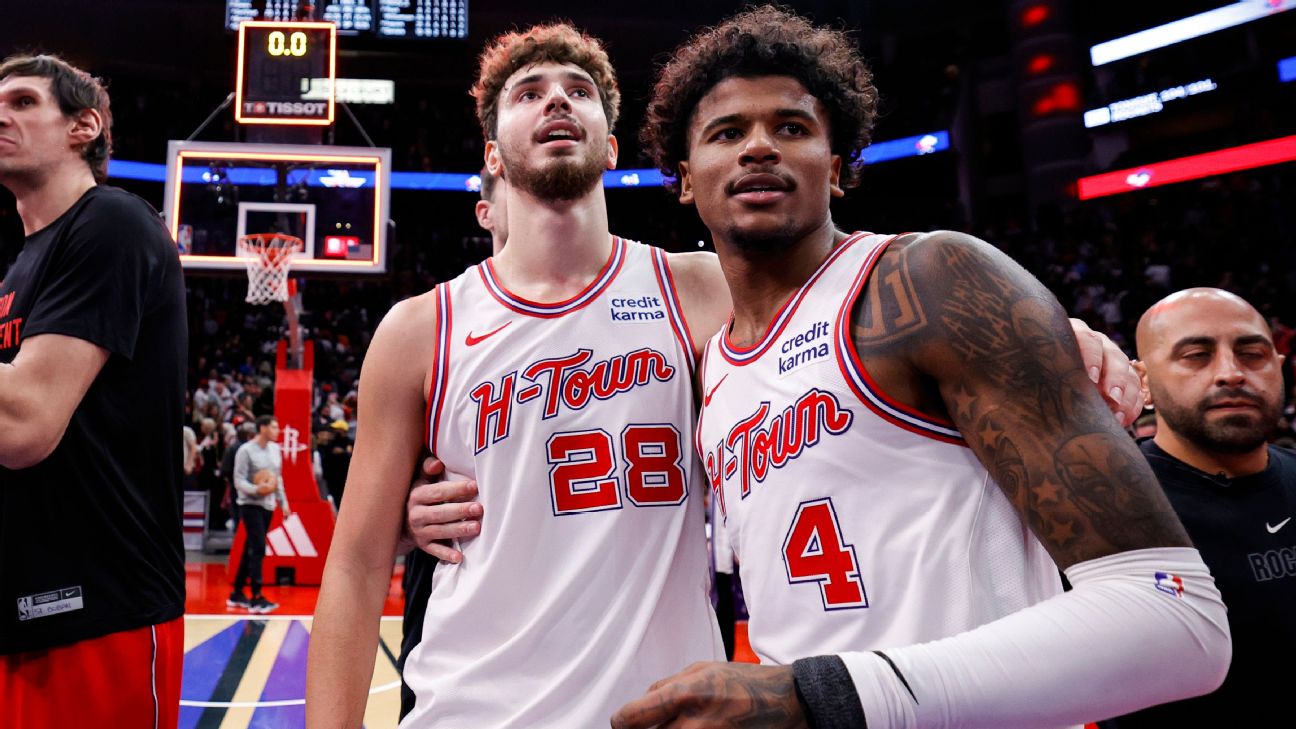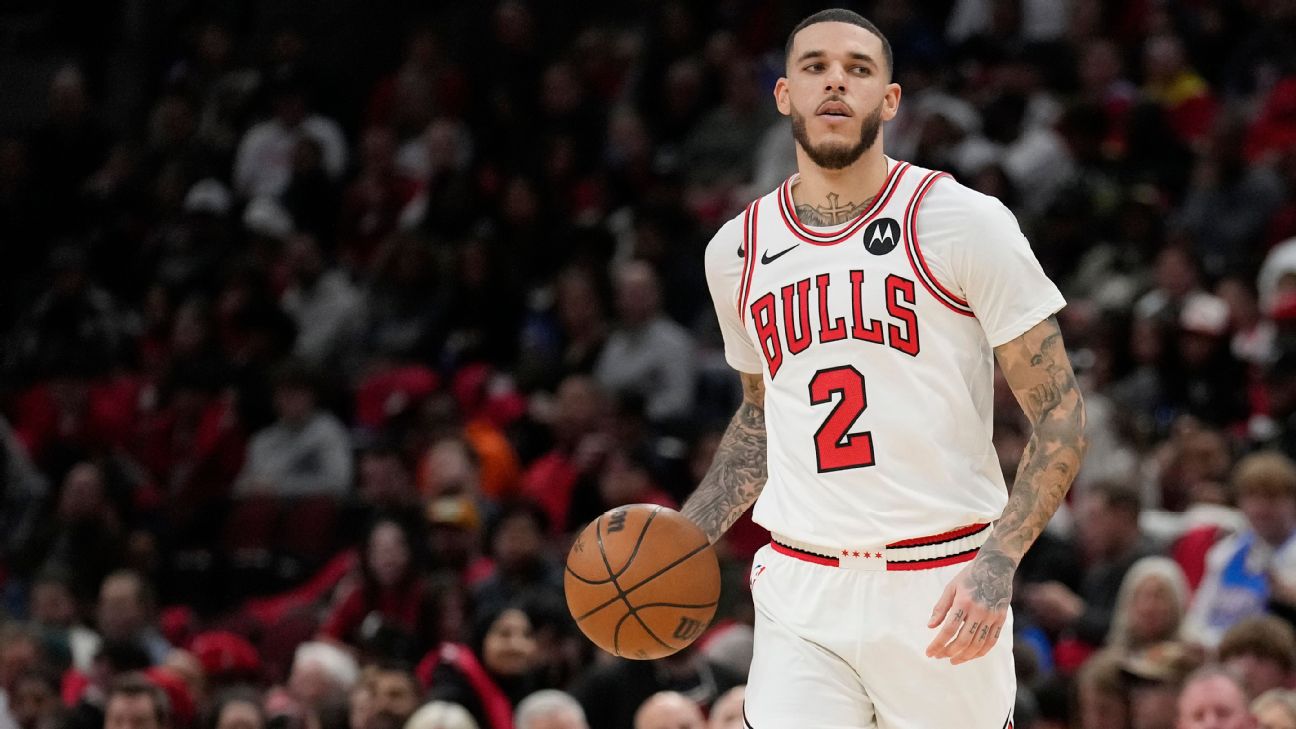The 2024-25 NBA season has begun, but several teams have signed notable players to contract extensions ahead of the games kicking into high gear.
Earlier this summer, four players drafted in the 2021 class — Detroit Pistons guard Cade Cunningham, Cleveland Cavaliers forward Evan Mobley, Toronto Raptors forward Scottie Barnes and Orlando Magic big man Franz Wagner — signed extensions for maximum deals worth five years, $225 million.
But with so few teams projected to have significant salary cap space next season amid new restrictions due to the collective bargaining agreement, other top young players locked in guaranteed money instead of waiting until free agency.
We have also seen two key veterans on two title contenders — Minnesota Timberwolves big man Rudy Gobert and Denver Nuggets forward Aaron Gordon — sign new long-term extensions.
ESPN NBA Insider Kevin Pelton reacts to these key deals and what they mean for their teams for this season and beyond.
Jump to a deal:
Gobert, Wolves reach $110M extension
Rockets sign top duo | Murphy nets new Pelicans deal
Suggs agrees to Magic extension | Gordon deal secures Nuggets core
Johnson, Hawks agree to extension | GSW’s Moody agrees to new 3-year deal
Kispert, Wizards agree to 4-year extension

-
Agreed to a reported three-year, $110 million extension with center Rudy Gobert
Grade: Pass (extensions graded on pass/fail scale)

Consider this an interesting contrast to the extension Aaron Gordon signed with the Denver Nuggets on Monday. Both Gobert and Gordon are key contributors to Western Conference contenders with luxury tax concerns, and both extensions will help the teams manage their tax bills.
The key difference between Gobert and Gordon was their current contracts. Whereas Gordon was on a bargain deal that included a $22.8 million player optionUtah Jazz before he was traded to Minnesota.
As a result, instead of exercising his option to facilitate an extension like Gordon, Gobert declined his and replaced it with a smaller 2025-26 salary as part of a longer contract that will add $54 million and two years to his total remaining. Declining the option meant Gobert was functionally in the final season of his contract, enabling him to sign an extension after Monday’s deadline for players with multiple years remaining.
To get technical, what Gobert and the Timberwolves did would not have been allowed under the previous NBA collective bargaining agreement, which prohibited extensions starting at a lower value than a declined option. The new CBA removed that restriction, recognizing the value for players in taking less money up front in order to make it up on the back end of the contract — something that’s always been possible during free agency. That’s precisely what Gobert is doing here.
His extension will pay less than Gobert could have made by exercising his option. However, by playing out his contract Gobert would have risked facing a tougher market as an unrestricted free agent in the summer of 2026 at age 34.
Given Gobert is still playing at a high level, having won his fourth Defensive Player of the Year award last season, there was a solid chance he would have merited at least $27 million per season as an unrestricted free agent. Still, this removes the downside potential if he got injured or saw his performance decline.
From Minnesota’s perspective, this is a huge financial win. Already projected to pay a luxury tax bill near $100 million for this season’s roster, the Timberwolves face the potential of raises for both of their other frontcourt players (newcomer Julius Randle and Sixth Man Award winner Naz Reid), who have 2025-26 player options of their own, plus reserve guard Nickeil Alexander-Walker hitting unrestricted free agency. Keeping the entire rotation together might still not be realistic for Minnesota.
Nine-figure luxury tax bills are hard to support for a small-market team, even one with championship aspirations. Nonetheless, reducing Gobert’s salary will help the Timberwolves maintain more depth heading toward Anthony Edwards’ prime years.
-
Agreed to a reported five-year, $185 million extension with center Alperen Sengun
-
Agreed to a reported three-year, $106 million extension with guard Jalen Green
Grade: Pass for Sengun deal, fail for Green deal

If you had set the over/under total on Rockets rookie extensions at 0.5, I probably would have taken the under. Instead, Houston ended up agreeing to deals with both of the team’s 2021 first-round picks, who have developed into core starters on a rising young team.
The Sengun extension is particularly surprising because the Rockets could have utilized his small $16.3 million cap hold to potentially create space next summer before re-signing him as a restricted free agent, similar to how the Philadelphia 76ers waited on signing Tyrese Maxey in order to sign Paul George.
But the two sides compromised on a deal that pays Sengun a little more than 80% of the expected $224 million max for rookie extensions. That’s a win for the Rockets given Sengun was as productive as any 2021 draft pick last season, when he averaged 21.1 PPG, 9.3 RPG and 5.0 APG and finished third in voting for Most Improved Player.
The trade-off that surely made this contract palatable for Sengun was getting a player option on the fifth year, a luxury that typically has been reserved for rookie extensions for elite players.
As ESPN’s Bobby Marks noted, Luka Doncic and Trae Young were the last two players to get that option. If Sengun develops into a superstar, Houston might regret not pushing for a straight five-year deal, particularly given even Maxey didn’t manage to get a player option on his new deal.
However, securing Sengun at considerably less than the maximum could prove important as the Rockets manage a number of quality young players graduating from rookie contracts to more lucrative extensions.
Green is one such case, and he got a creative extension that might work better for him than for Houston. The negotiations with Green figured to be complicated by differing views on his value around the league. The No. 2 pick in the 2021 draft, Green hadn’t yet played up to the max level achieved by the other three players taken in the top four (Cunningham, Mobley, Barnes) — all of whom already agreed to extensions over the summer.
Green has shown flashes of the stardom expected when he was drafted, especially in last season’s final 18 games where he averaged 24.2 points, 6.6 rebounds and 4.3 assists with above-average efficiency after Sengun suffered a season-ending ankle injury.
Given the difficulty finding elite shooting guards and Green’s age (22), that kind of performance merited max or near-max compensation. However, much of the Rockets’ success in that span came against lottery-bound teams, and Green’s efficiency was buoyed by far better 3-point shooting (38%) than in the first three-quarters of the season (31%).
As ESPN’s Shams Charania reported, Green is the first player to sign a three-year rookie extension with a player option. Typically, player options in rookie extensions have been limited to elite superstars who can command them in the final season of a five-year max deal. This structure is very different, putting Green potentially in unrestricted free agency in the summer of 2027 at age 25.
Alternatively, Marks pointed out that a three-year extension with a player option gives both sides the flexibility of negotiating an extension in October 2026 ahead of Green’s option. But if Green develops as he and Houston hope, he’ll be negotiating from a much stronger position.
With Sengun’s extension taking the Rockets out of the running for significant 2025 cap space, I think I’d probably have favored waiting to re-sign Green in restricted free agency next summer. Green will have to develop quickly into a star to be worth much more than his salary in this extension, and if he does, Houston will wish this contract was longer.
-
Agreed to a reported four-year, $112 million extension with forward Trey Murphy III
Grade: Pass

After playing fewer than a thousand minutes as a rookie, Murphy has been one of the most consistent performers from the 2021 draft class, averaging 14.6 PPG over the past two seasons while shooting 39% on 3s and 61% on 2s.
Add Murphy’s size (6-foot-8) and ability to capably defend multiple positions and he’s exactly the kind of role player every good team needs. That gave him considerable leverage in extension negotiations despite the fact that he started just 23 of his 57 games last season.
Although Murphy was apparently still playing with New Orleans’ second unit during training camp before suffering a hamstring strain that will sideline him to begin the season, his ascension to the starting lineup is only a matter of time.
Murphy’s shooting helps open things up for the rest of the Pelicans’ offense. Last season, New Orleans’ net rating was 4.6 points better per 100 possessions with Murphy on the court, per NBA Advanced Stats. As the cap rises, this extension will pay Murphy like an average starter. Next season, he’ll make approximately 16% of the team’s salary cap. By 2028-29, the final year of the deal, that should decline slightly to 15% with Murphy in the middle of his prime at age 28. I’d consider this a fair deal for the Pelicans if Murphy merely continues to perform at the same level.
If he improves, it could be a bargain. There are still difficult decisions to come for the Pelicans. As Marks noted, adding in a starting salary of $25 million for Murphy (with maximum 8% annual raises) puts them about $31 million below the 2025-26 luxury-tax line with key starter Brandon Ingram headed for unrestricted free agency. That predicament helps explain why Ingram hasn’t been extended heading into the final season of his contract.
On the open market, Ingram would likely command far more than $30 million, leaving New Orleans with three options: pay the luxury tax for a year, trade him for a player who will earn less or make another money-saving move. The obvious alternative is trading guard CJ McCollum, who will make $30.7 million in the final season of his extension in 2025-26.
Whoever else the Pelicans might have to sacrifice, they aren’t as important to the team’s future as Murphy — including Ingram, who’s three years older and a trickier fit alongside Dejounte Murray and Zion Williamson. Getting Murphy extended was a necessary piece of business that prevents him from really breaking the bank with a breakout season.
-
Agreed to a reported five-year, $150.5 million extension with guard Jalen Suggs
Grade: Pass

Suggs picked a good time to enjoy a breakthrough campaign. Drafted No. 5 out of Gonzaga, Suggs averaged 11.8 PPG and 4.4 APG as a rookie but shot just 21% from 3-point range. Suggs saw his role diminish as a sophomore, averaging 23.5 MPG after playing 27.2 as a rookie.
Things clicked at both ends for Suggs in Year 3. He made the All-Defensive second team as perhaps the NBA’s preeminent on-ball defender, hounding ball handlers with enough size to hold up on switches and offering defensive playmaking. Among players 6-foot-5 or under with at least 1,000 minutes, Suggs was one of just four to record at least two steals per 100 possessions.
On offense, Suggs took an enormous step forward as a jump shooter. Having improved somewhat to 33% on 3s in his second season, Suggs saw his percentage skyrocket to 40% in 2023-24, allowing him to score efficiently and provide the Magic’s offense needed spacing in an off-ball role.
He hasn’t shown the same kind of progress at the foul line, where last season’s 76% accuracy was almost right on his career mark. However, my research hasn’t found that to be as important an indicator in the NBA as for college players.
The bigger factor in Suggs’ long-term value will be his development as a playmaker. According to lineup data from NBA Advanced Stats, Suggs spent nearly two-thirds of his minutes at shooting guard last season but figures to shift back to an on-ball role with the arrival of Kentavious Caldwell-Pope.
Even with the ability of forwards Paolo Banchero and Franz Wagner to initiate the offense, the Magic will surely ask more of Suggs, whose 2.7 assists per game last season was the lowest mark of his career.
Beyond that, Suggs’ league-average usage rate was also a career low. Orlando would undoubtedly love to see him ramp that up this season and eventually emerge as a third shot creator alongside Banchero and Wagner. Intriguingly, Suggs was actually better relative to league average on self-created shots (with a touch time of more than two seconds, according to NBA Advanced Stats) than those set up by teammates last season
As long as Suggs can be the 3-and-D role player he was last season, this extension is about fair. Minnesota’s Jaden McDaniels — another All-Defensive second team selection — signed a rookie extension for five years and $136 million a year ago. Based on the projected 10% jump in the salary cap, Suggs’ $150 million is an equivalent contract a year later.
If Suggs adds more shot creation, the Magic could get a bargain. Suggs is also protecting himself against a potential decline from 3-point range that could have left him hitting restricted free agency looking more like a defensive specialist.
Looking ahead, Orlando’s penchant for utilizing team options offers plenty of payroll flexibility for 2025-26. Remarkably, every Magic player on a full NBA contract (i.e. not a two-way) is now signed through next season. Orlando would edge into the luxury tax by keeping all of them but can easily manage the 2025-26 payroll without much pain.
The Magic’s cap sheet will get trickier in 2026-27, when Banchero will likely begin a max rookie extension of his own. Orlando will almost certainly have to shed some salary by then to avoid paying the tax, but it’s plausible the young Magic — whose average age weighted by minutes played was fourth youngest in the NBA — could develop by then into contenders capable of justifying a tax bill.
-
Agreed to a reported three-year, $133 million extension with forward Aaron Gordon
Grade: Pass

Monday was also the deadline for veteran extensions for players with multiple seasons left on their contract, which is why Gordon inked a new deal that will see him exercise a $22.8 million player option for 2025-26, then add three years for the reported total of $133 million ( including $109 million in new money) beyond the upcoming season.
That player option is important for Denver because Gordon figured to command significantly more than $22.8 million as an unrestricted free agent next summer had he declined the option, as reflected by his average salary of approximately $36 million during the new extension. By putting that maximum 40% raise off until 2026-27, the Nuggets can mitigate their tax bill next season, when they’ll be subject to the repeater tax for the first time if they pay the luxury tax this season as projected.
Whatever the mechanism, retaining Gordon was crucial for Denver given his strong fit alongside Nikola Jokic in the Nuggets’ championship-winning frontcourt. Gordon’s defensive versatility and above-the-rim finishing helped elevate Denver when he arrived from the Orlando Magic at the 2021 trade deadline. That made Gordon a keeper while the Nuggets deemed starting guard Kentavious Caldwell-Pope expendable when they allowed him to leave in free agency over the offseason. Gordon’s age (29) also fits better with Denver’s core of Jokic (also 29) and Jamal Murray (27) than the 31-year-old Caldwell-Pope.
The Nuggets are taking some risk of overpaying Gordon on the back end of this extension, which pays him through age 33. Because he’s more reliant on athletic ability than skill, Gordon might find it difficult to extend his prime. The Nuggets should be focused on winning championships while Jokic is the NBA’s best player, and retaining Gordon helps maintain that window so long as Denver can find enough perimeter production to replace Caldwell-Pope.
The timing of Gordon’s extension is interesting because it came concurrently with the Rockets scrapping their potential 2025 cap space by agreeing to an extension that pays center Alperen Sengun far more than his cap hit as a restricted free agent. Gordon would have been a top target for Houston had he tested free agency, and it’s possible that Gordon’s new deal with Denver helped convince the Rockets to give up on their aspirations.
-
Agreed to a reported five-year, $150 million extension with forward Jalen Johnson
Grade: Pass

One of the fastest rising players in the 2021 draft class, Johnson went from the fringes of the Hawks’ rotation in 2022-23 to being a core performer. Johnson, who will make $26.6 million in the final year of his contract, would have been a strong candidate for Most Improved Player had he played enough games to qualify. Johnson averaged 16.1 points, 8.7 rebounds and 3.6 assists and also supplied more floor spacing than John Collins in the 4-spot, more than doubling his previous career high with 71 3-pointers at a 35.5% clip.
Given shooting was the biggest question about Johnson’s game coming out of Duke, that development — which was matched by going from 63% on free throws in Year 2 to 73% during 2023-24 — was critical. With Dejounte Murray traded to the New Orleans Pelicans, Johnson has a chance to emerge as Atlanta’s second option on offense after Trae Young this season. Based on that potential for Johnson to add scoring, the Hawks were wise to get him signed to an extension at similar value to the one the Orlando Magic gave guard Jalen Suggs.
The structure of this contract is interesting. Per ESPN’s Bobby Marks, Johnson’s salary will be a flat $30 million over the life of the extension. That gives Atlanta a little less breathing room with regards to the 2025-26 luxury tax. Factoring in filling out the salary with minimum contracts, the Hawks will have somewhere in the range of $17 million to spend on either re-signing starting center Clint Capela or using their non-taxpayer midlevel extension without pushing into the tax. That presumes, of course, that the Hawks stick with their current core. If Atlanta misses the playoffs and sends a lottery pick to the San Antonio Spurs from the original Murray trade, bigger changes could loom.
Either way, Johnson has solidified himself as part of the Hawks’ core at age 22. Atlanta will benefit from Johnson’s salary staying flat while the cap is expected to increase the maximum 10% annually due to the NBA’s new national TV deal. By 2029-30, the last year of Johnson’s extension, his salary will represent just 14.5% of the projected cap, as compared to 19.4% next season.
-
Agreed to a reported three-year, $39 million extension with guard Moses Moody

Grade: Pass
When the Warriors signed De’Anthony Melton and acquired Kyle Anderson and Buddy Hield in sign-and-trade deals after losing Klay Thompson, it looked discouraging for Moody’s long-term prospects in the Bay.
Despite productive play when given an opportunity last season, including 16.7 points and 6.2 rebounds per 36 minutes, Moody found it difficult to maintain a consistent spot in coach Steve Kerr’s rotation. He averaged just 17.5 MPG and received a handful of DNP-CDs when Golden State was at full strength.
Yet in the wake of Moody averaging a team-high 15.5 PPG during the preseason, the Warriors’ front office showed its commitment to him with this extension. This contract is similar to what Moody might have been offered by another team using the non-taxpayer midlevel exception. The full exemption was worth $40 million over three years this offseason and projects to increase with the cap to $44.4 million next summer.
Given only the Warriors actually signed a player (Melton) to the full value of the non-tax midlevel exception, getting the vast majority of it — with $1.5 million of that coming via incentives, per ESPN’s Bobby Marks — is a pretty good outcome for Moody. At the same time, Golden State has a chance to win big on this deal if Moody emerges as a starter.
Moody will be 23 at the start of this extension and developing into a capable starter by the end of it is perfectly reasonable. If Moody makes that kind of jump, the upside for him is that a three-year deal gets him into unrestricted free agency at age 26. By then, Moody could merit a bigger payday.
-
Agreed to a reported four-year, $60 million extension with forward Corey Kispert

Grade: Pass
After parlaying a modest extension for forward Deni Avdija last fall into considerable trade value this summer — the Portland Trail Blazers sent back two first-round picks, including the No. 14 selection this year the Wizards used on guard Bub Carrington — Washington is trying to run that formula back with Kispert. Like with Avdija’s extension, Kispert’s contract will start at its highest point ($14 million), per ESPN’s Bobby Marks.
Additionally, the final season is a team option. As noted by Fred Katz of The Athletic, Kispert’s starting salary conveniently fits into next season’s projected non-taxpayer midlevel exception, allowing another team to acquire Kispert via trade using that exception under a rule introduced in the new NBA collective bargaining agreement.
Surely, Washington will be OK simply hanging on to Kispert to provide necessary floor spacing as the Wizards’ younger prospects develop. After adjusting to the NBA 3-point line as a rookie, Kispert has shot 40% from beyond the arc during the past two seasons, averaging better than two makes per game. At 25, Kispert has established himself as a credible starter or above-average backup heading into his prime years.



